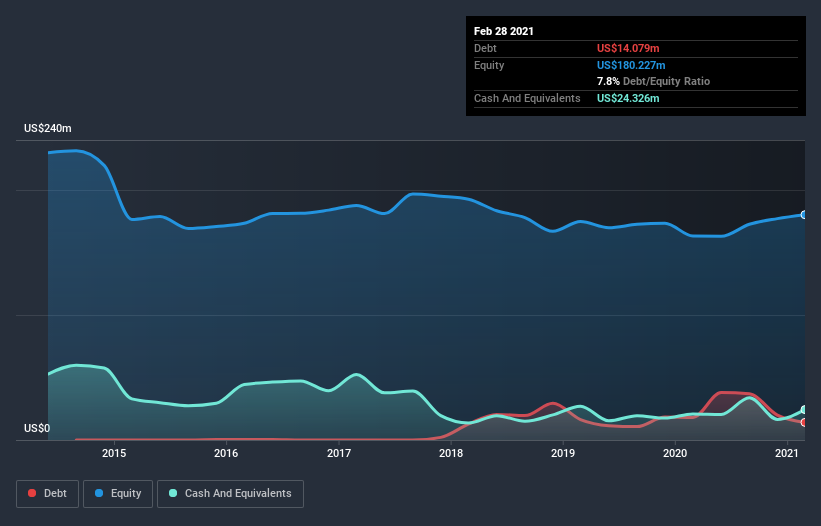EXFO (TSE:EXF) Seems To Use Debt Quite Sensibly
The external fund manager backed by Berkshire Hathaway's Charlie Munger, Li Lu, makes no bones about it when he says 'The biggest investment risk is not the volatility of prices, but whether you will suffer a permanent loss of capital.' So it might be obvious that you need to consider debt, when you think about how risky any given stock is, because too much debt can sink a company. Importantly, EXFO Inc. (TSE:EXF) does carry debt. But the real question is whether this debt is making the company risky.
When Is Debt Dangerous?
Debt is a tool to help businesses grow, but if a business is incapable of paying off its lenders, then it exists at their mercy. If things get really bad, the lenders can take control of the business. However, a more common (but still painful) scenario is that it has to raise new equity capital at a low price, thus permanently diluting shareholders. By replacing dilution, though, debt can be an extremely good tool for businesses that need capital to invest in growth at high rates of return. The first thing to do when considering how much debt a business uses is to look at its cash and debt together.
View our latest analysis for EXFO
How Much Debt Does EXFO Carry?
You can click the graphic below for the historical numbers, but it shows that EXFO had US$14.1m of debt in February 2021, down from US$18.1m, one year before. However, it does have US$24.3m in cash offsetting this, leading to net cash of US$10.2m.
How Healthy Is EXFO's Balance Sheet?
Zooming in on the latest balance sheet data, we can see that EXFO had liabilities of US$93.7m due within 12 months and liabilities of US$22.7m due beyond that. On the other hand, it had cash of US$24.3m and US$63.8m worth of receivables due within a year. So it has liabilities totalling US$28.2m more than its cash and near-term receivables, combined.
Since publicly traded EXFO shares are worth a total of US$225.1m, it seems unlikely that this level of liabilities would be a major threat. But there are sufficient liabilities that we would certainly recommend shareholders continue to monitor the balance sheet, going forward. While it does have liabilities worth noting, EXFO also has more cash than debt, so we're pretty confident it can manage its debt safely.
Pleasingly, EXFO is growing its EBIT faster than former Australian PM Bob Hawke downs a yard glass, boasting a 1,145% gain in the last twelve months. The balance sheet is clearly the area to focus on when you are analysing debt. But ultimately the future profitability of the business will decide if EXFO can strengthen its balance sheet over time. So if you're focused on the future you can check out this free report showing analyst profit forecasts.
But our final consideration is also important, because a company cannot pay debt with paper profits; it needs cold hard cash. While EXFO has net cash on its balance sheet, it's still worth taking a look at its ability to convert earnings before interest and tax (EBIT) to free cash flow, to help us understand how quickly it is building (or eroding) that cash balance. Over the most recent two years, EXFO recorded free cash flow worth 64% of its EBIT, which is around normal, given free cash flow excludes interest and tax. This free cash flow puts the company in a good position to pay down debt, when appropriate.
Summing up
While EXFO does have more liabilities than liquid assets, it also has net cash of US$10.2m. And we liked the look of last year's 1,145% year-on-year EBIT growth. So we don't think EXFO's use of debt is risky. There's no doubt that we learn most about debt from the balance sheet. However, not all investment risk resides within the balance sheet - far from it. To that end, you should be aware of the 2 warning signs we've spotted with EXFO .
Of course, if you're the type of investor who prefers buying stocks without the burden of debt, then don't hesitate to discover our exclusive list of net cash growth stocks, today.
This article by Simply Wall St is general in nature. It does not constitute a recommendation to buy or sell any stock, and does not take account of your objectives, or your financial situation. We aim to bring you long-term focused analysis driven by fundamental data. Note that our analysis may not factor in the latest price-sensitive company announcements or qualitative material. Simply Wall St has no position in any stocks mentioned.
Have feedback on this article? Concerned about the content? Get in touch with us directly. Alternatively, email editorial-team (at) simplywallst.com.

